In his Lives, Giorgio Vasari does not give an enthusiastic judgment of theAdoration of the Magi that Perugino (Pietro Vannucci; Città della Pieve, c. 1448 - Fontignano, 1523) painted for the church of Santa Maria dei Servi in Perugia, now preserved in the first room dedicated to him in the National Gallery of Umbria. In fact, the historian from Arezzo says that “in the church of Servi he made [...] two panels, in one the Transfiguration of Our Lord and in the other, which is next to the sacristy, the story of the Magi; but because these are not of that goodness that are the other things of Piero, it is held to be firm that they are of the first works that he did.” On the Transfiguration altarpiece Vasari was wrong about the chronology: it is in fact a late work, executed by the artist shortly before 1517, and indeed it is not usually considered among Perugino’s best works. TheAdoration of the Magi , on the other hand, is truly a youthful work, but Vasari is too harsh in deeming it not up to the standards of other works Perugino would later execute. Instead, it is a panel that, in addition to standing out for its grandeur (a feature that helps make it immediately recognizable, and that inevitably captures visitors to the Perugia museum), holds some elements that make it one of the most interesting works of Perugino’s entire production.
It is, in all probability, the first major commission that Perugino received after the end of his apprenticeship in Florence, which lasted until 1472, the year in which the artist enrolled in the Compagnia di San Luca in Florence, a kind of association that, within the Arte dei Medici e degli Speziali (one of the main professional guilds in Florence), gathered painters and promoted their work, in the name of the patron saint of artists. In 1472, Perugino is listed as a “painter” who was a member of the Company: we are therefore certain that from this year he had become an independent artist. However, there is no agreement on the precise dating of theAdoration of the Magi, although critics are unanimous in considering it the work of the 1470s. Therefore, the work of an artist in his early twenties, who was still finding his own way, as noted by Umberto Gnoli, author of a pioneering monograph on the artist in 1923. “The personality of the Master is not fixed,” he wrote: “the great tree in the center of the landscape is a reminiscence of Piero dal Borgo; the hands of St. Joseph have the hardness of those of Luca Signorelli; the figures, plastically draped, are Florentine, but mellowed. The Master still looks around him, studies his great contemporaries, labors in problems of technique, lingers in virtuosity of light and shadow, as in the deep party of folds of the seated Virgin, but moves nobly in the orbit of Tuscan painting, without having found himself, almost not daring to manifest the originality of his genius.” However, there is no lack of elements that would become characteristic of Perugino’s art, as will be seen.

However, it is true that this is a painting that looks very much to Tuscan painting of the time and is deeply influenced by the environment in which Perugino was formed, Tuscany and more precisely the Florence of the second generation of the Renaissance, that of Piero della Francesca, Luca Signorelli, Verrocchio, Sandro Botticelli, and Antonio and Piero del Pollaiolo. The composition is sharply marked by the vertical lines created by the mountainous landscape on the left, the tree in the center, and the poles of the hut on the right. The hut, moreover, is described with obvious finesse: “Perugino,” Marco Pierini has written, “does not hide his love of detail: the stone ashlars are chipped, the beams harbor weedy seedlings, the wooden columns are anchored with tightly knotted reed, tufts of straw, a now-useless thermal insulator, sprout from the roof.” Within this score the scene takes place: the procession of Magi is crowded under the tree, a step away from the Holy Family, which is instead standing still under the hut. Connecting the two groups, in the background, the ox and donkey move their heads behind a palisade. The procession is opened by the three magi: the older one is kneeling at the feet of the Child with his head uncovered, while the other two, the mature one and the young one, are standing behind him and nonchalantly offering their gifts with affected gestures (note the way the young magician holds the cup of incense, resting on the knuckles of his first three fingers. They are attired in luxurious robes: the youngest of the three wears youthful garb, namely, tights covered at the bottom by a pair of boots with lapels, a green velvet jornea edged with white fur, worn over a white shirt, and a red cloak fastened with a gaudy gold chain.
More traditional, however, is the clothing of the mature king, who wears an ankle-length robe of gold brocade, also covered by a broad cloak. The Magi are accompanied by a host of pages and attendants also dressed in fine clothes and caught in fine poses. On the far left, one of the characters in the procession looks toward the viewer: this is the typical device that artists used to self-represent themselves. Moreover, the fact that the character in question has a conspicuous red spot under his right eye does not leave too many doubts, since in his certain portraits Perugino manifests this skin problem: in theAdoration of the Magi we thus get to see (as the writer Karl Friedrich von Rumohr had first observed as early as 1827) the artist as a young man, handsome and decidedly fitter than he would appear in the portraits of his maturity. On the other side, the Child is caught in the act of blessing the king who has knelt before him. The Virgin, with refined movements, gently holds him in her hands, turning her gaze at once gentle and haughty to the sovereign who has come from afar to reverence the son of God. Behind, Saint Joseph watches the scene while leaning on his staff. The background is a gentle Umbrian landscape that shows Perugino’s good mastery of aerial perspective, as can be seen in the mountains in the distance painted blurred and in cooler tones. An expanse of water is visible: it is Lake Trasimeno, another recurring presence in Perugino’s works. And then there are accurately described plants, mostly recognized by Pierini, according to whom the artist could rely partly on direct observation, and partly on some herbarium he probably had in his workshop. The tree similar to the one in Piero della Francesca’s Baptism of Christ is a rowan tree, and behind it we see bushes of viburnum, a few specimens of manna ash, a cypress (we see it immediately next to the stem of the tree), and a spruce (next to the cypress) painted schematically. Clinging to the rocks, on the other hand, are a cymbalaria at the top and, further down, a buttercup and a plantain. Finally, high up in the landscape, here is the comet star that guided the Magi to Jesus’ hut: again, Perugino may perhaps have had direct experience of such an astrological phenomenon, since the skies of Tuscany are documented with the passage of two comets, one in August 1468 and one in January 1472. The fact that Perugino seeks to paint the comet as realistically as possible may therefore suggest a specific desire to describe the event he may have had the good fortune to witness.


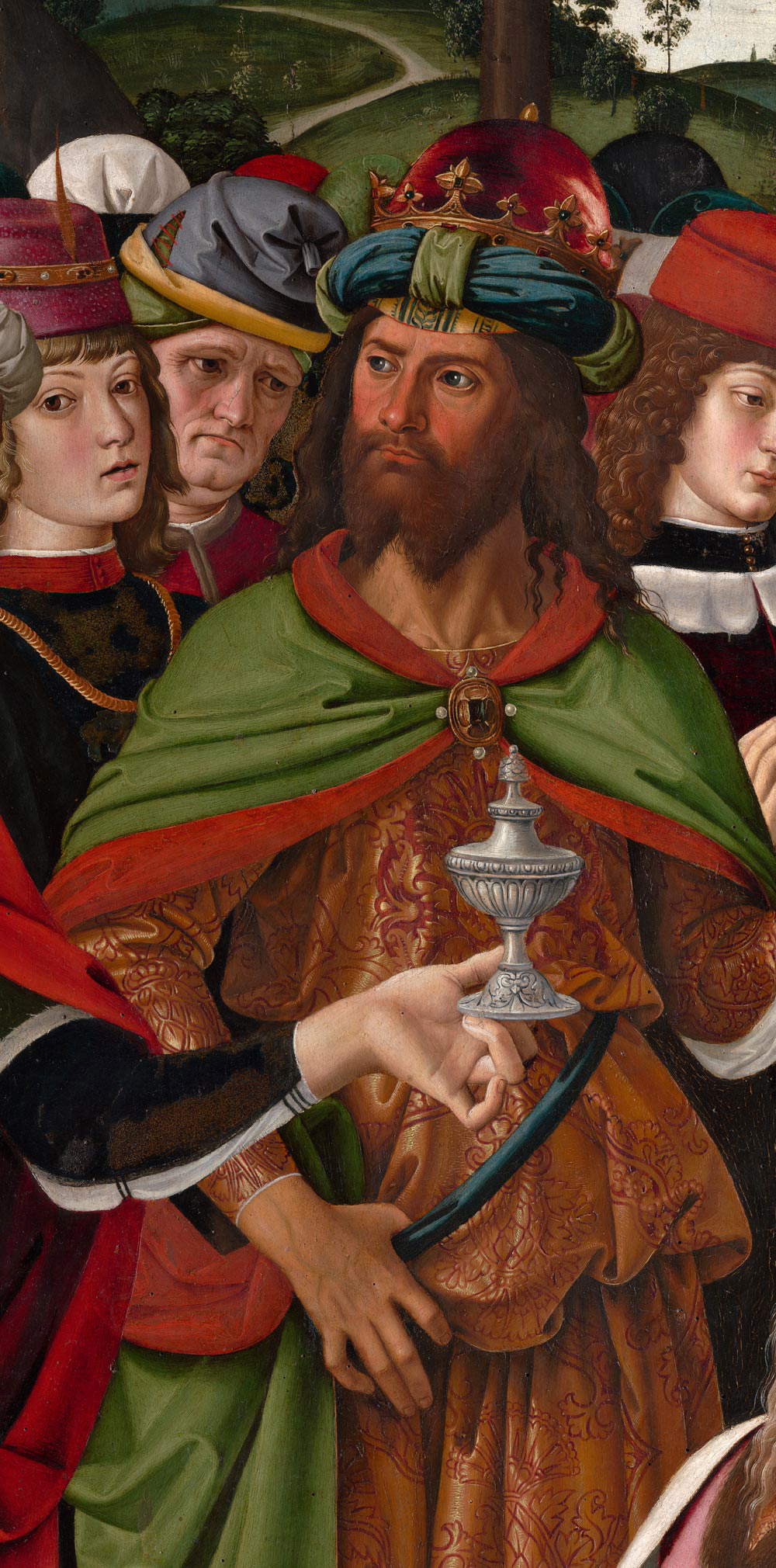
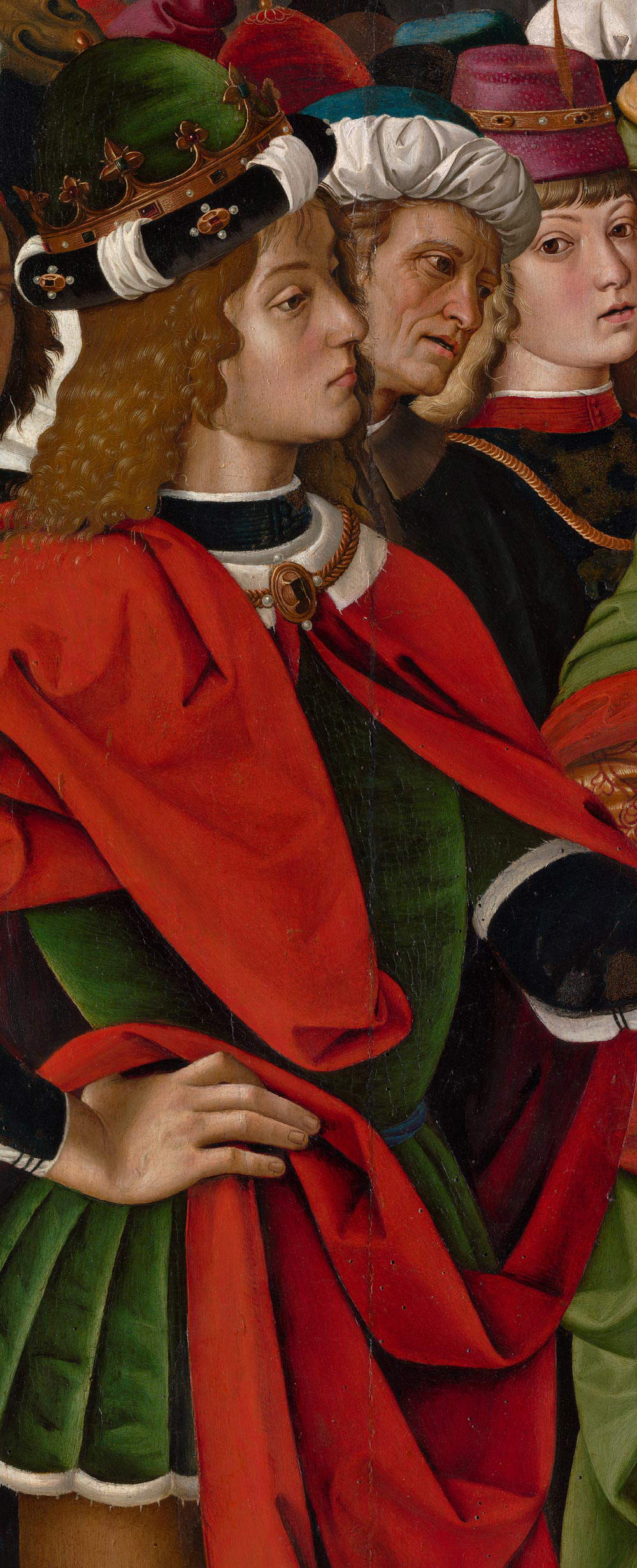
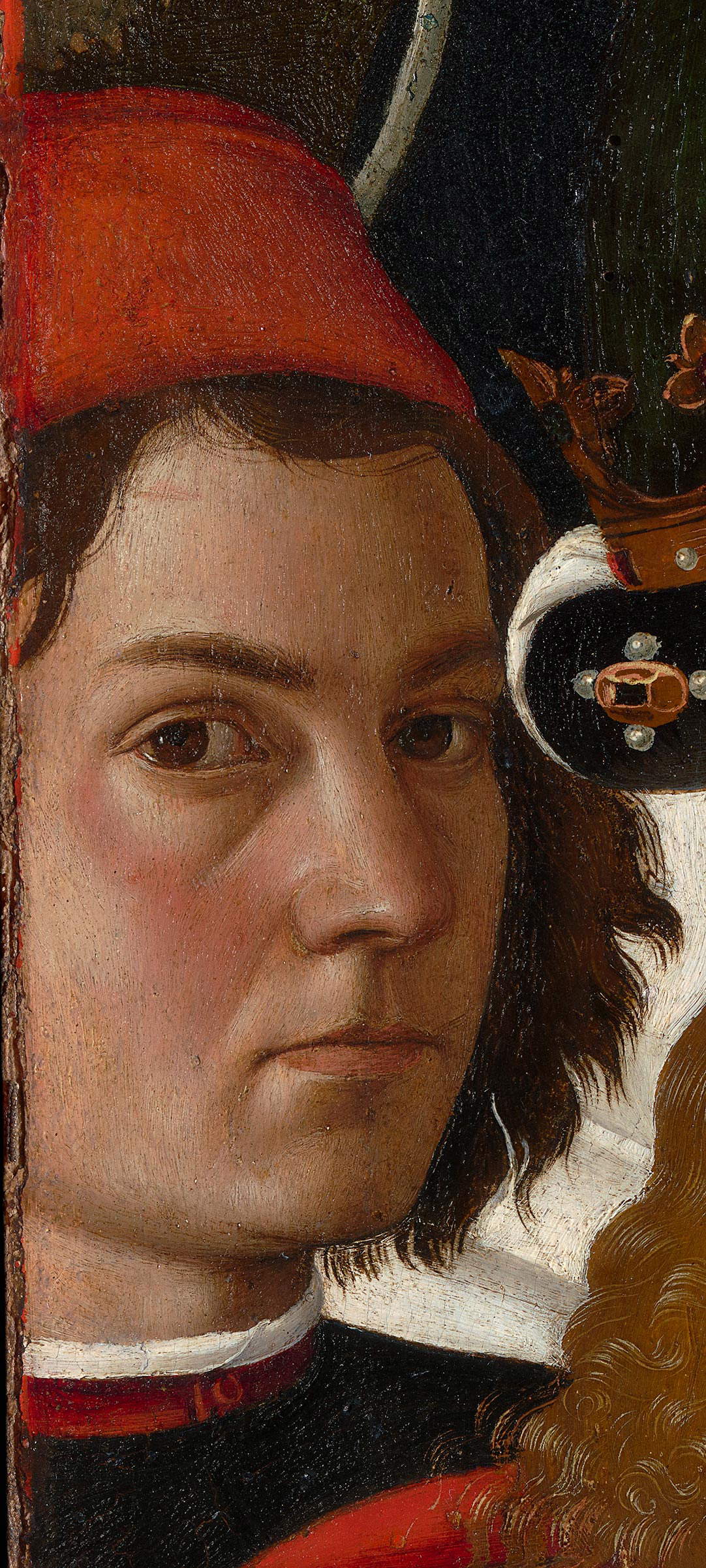

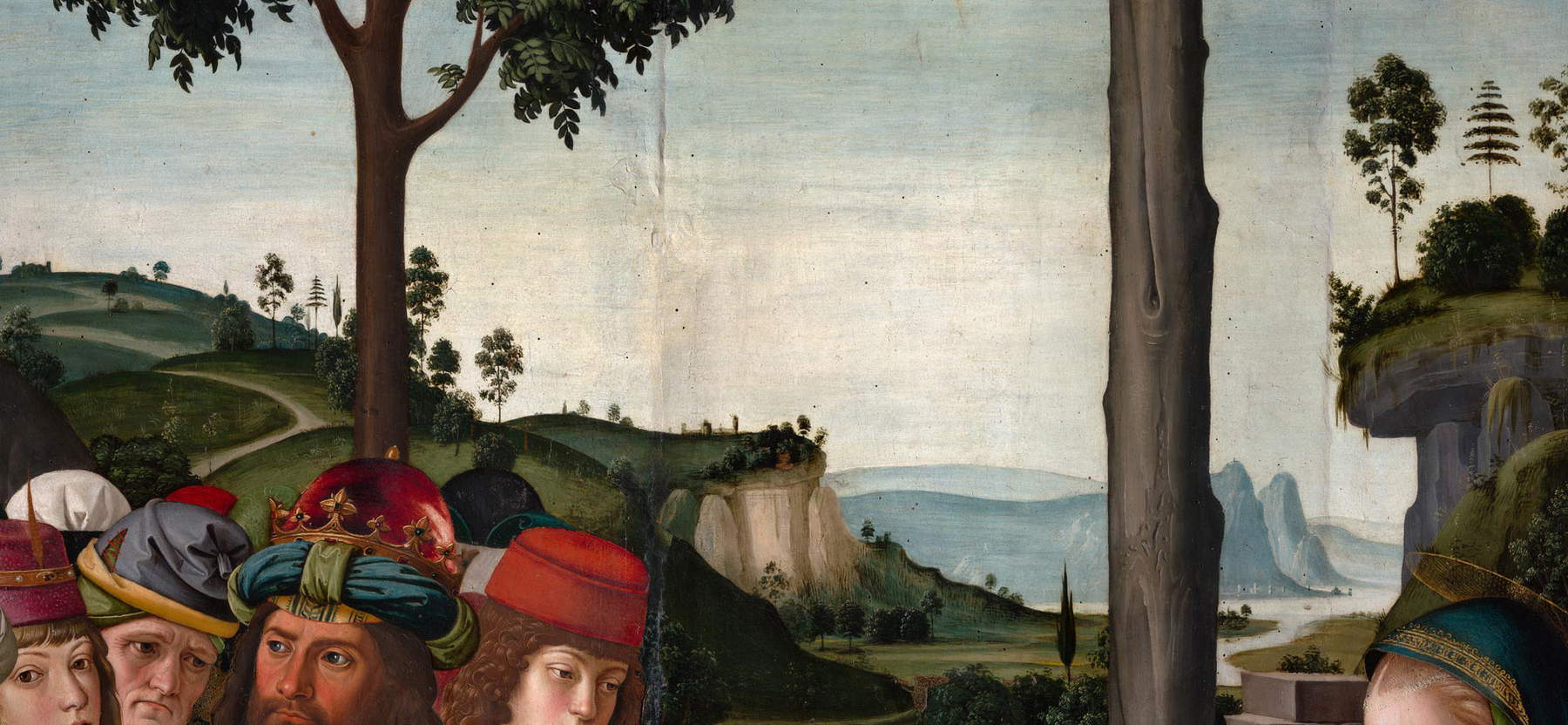
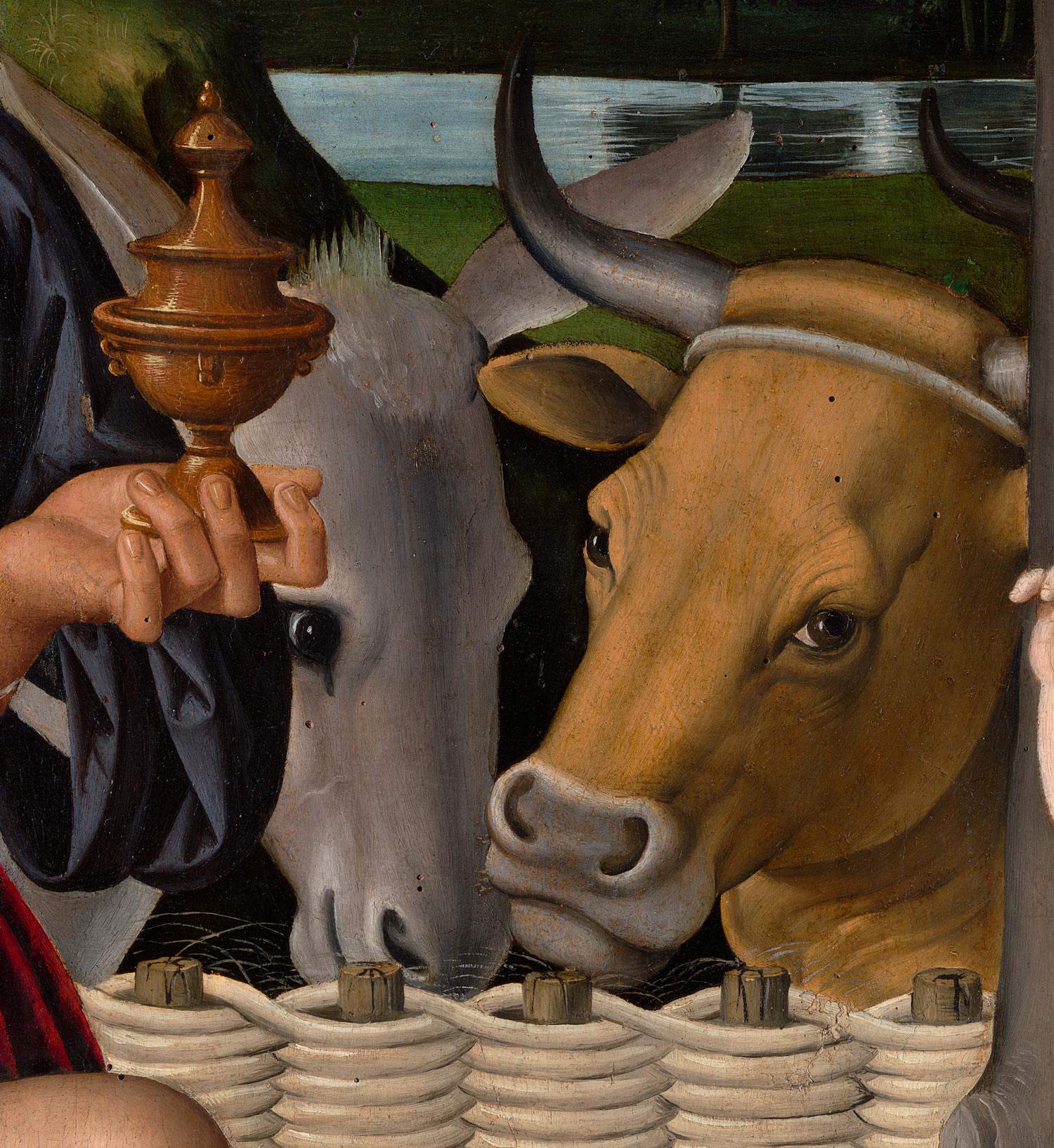

As Gnoli observed, theAdoration of the Magi is a sort of summary of the references of an artist who sought a kind of mediation between ancient and modern models, between tradition that was still Gothic and novelties introduced by the most up-to-date painters of the time. They hark back to the former, for example, the robes of the characters that seem almost to be made of metal, painted with draperies with stiff, sharp, heavy folds, giving the garments a late Gothic sculpture-like relief (look, for example, at the way the kneeling king’s robe falls behind him, but look also at the folds of St. Joseph’s tunic that describe wide, rigid semi-circular folds on the lower part of the body, like those seen in certain statues by Lorenzo Ghiberti). There are many innovative elements, however. Beginning with the tree in the center, a direct quotation from Piero della Francesca’s Baptism of Christ , which was at the center of the Polyptych of San Giovanni in Val d’Afra, in Sansepolcro, while now in the National Gallery in London. The figures then display a plasticism that has been related to the works of the Pollaiolo brothers and those of Verrocchio, and then again the minuteness of the decorations (note in this regard the robe of the mature magician) that has been compared to that of Flemish art (just as of Flemish derivation is the use of oil), the landscape reminiscent of the creations of the young Leonardo da Vinci, almost the same age as Perugino. These are all elements that highlight the qualities of an attentive and up-to-date painter such as the young Pietro Vannucci was.
Then there are some details typical of Perugino, which will also return in other of his mature works: for example, the young men dressed in fashionable robes and headgear or the individually characterized characters who will go on to populate other crowded Perugino scenes (the example of the fresco with the Delivery of the Keys of the Sistine Chapel may be worth all of them: scholar Giancarlo Gentili has argued that theAdoration of the Magi constitutes the first example of such a commitment by Perugino to the systematic use of portraiture, which would recur then other times in his art, though not frequently), or the young king himself, Melchior, whose figure will be taken up for the Saint Roch in the fresco executed by the artist for the church of San Francesco in Deruta and now housed in the Umbrian town’s Pinacoteca Comunale. Certain elements, symbolic rather than formal, hark back to another important Adoration of the Magi painted in the mid-1470s, the one Sandro Botticelli executed around 1475 for the funeral chapel of the Medici courtier Gaspare di Zanobi del Lama in Santa Maria Novella, and now preserved in the Uffizi. Similar is the idea of depicting the hut as a ruined temple, an allusion to the pagan age that is overcome (and thus left in ruins) by the birth of Jesus Christ, identical is the idea of including in the composition a self-portrait as well as according to some scholars in both works is the expedient of portraying in the scene some contemporary characters. Thus, if Sandro Botticelli’sAdoration was a kind of celebration of Medici power (portraits of Cosimo the Elder, Piero the Gouty, Lorenzo the Magnificent, and his brother Giuliano could be seen there), Perugino’s may have replicated this typically Florentine habit (it is attested after all also in a perhaps even more famousAdoration , the one painted by Benozzo Gozzoli in the chapel of the Medici Riccardi Palace) with the inclusion in the Gospel episode of some portraits of the Baglioni family, which dominated Perugia at the time.


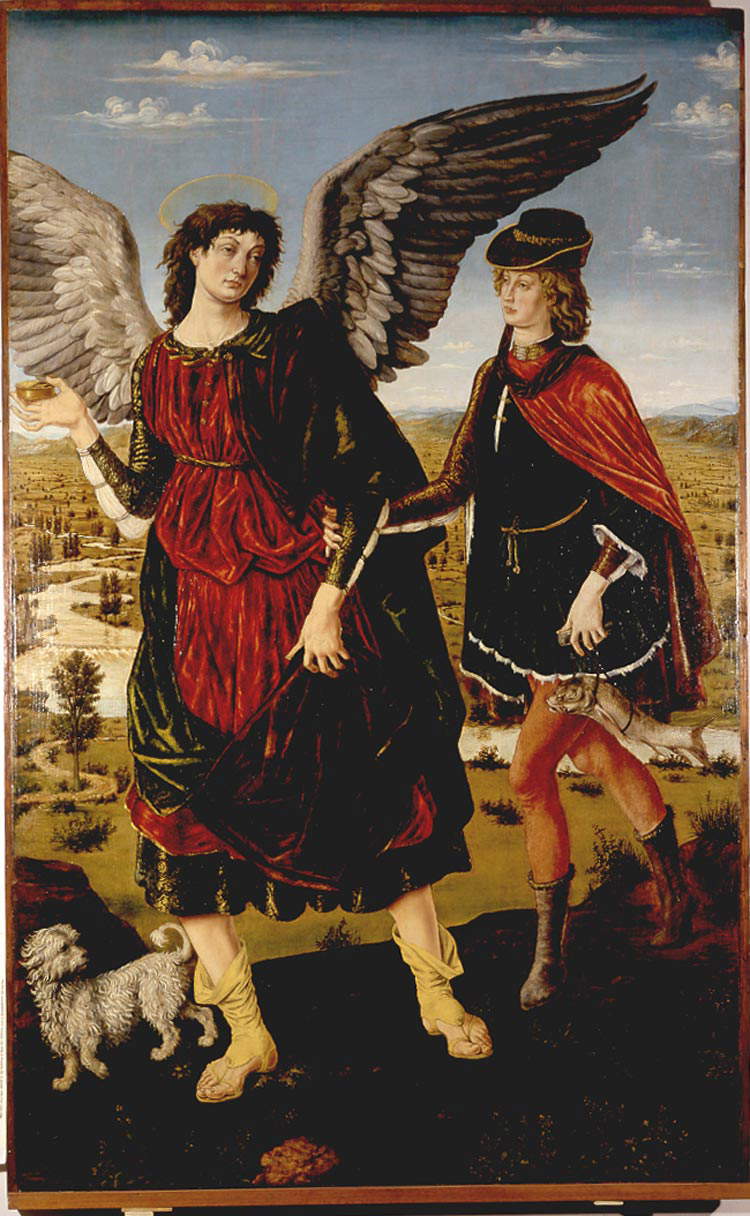
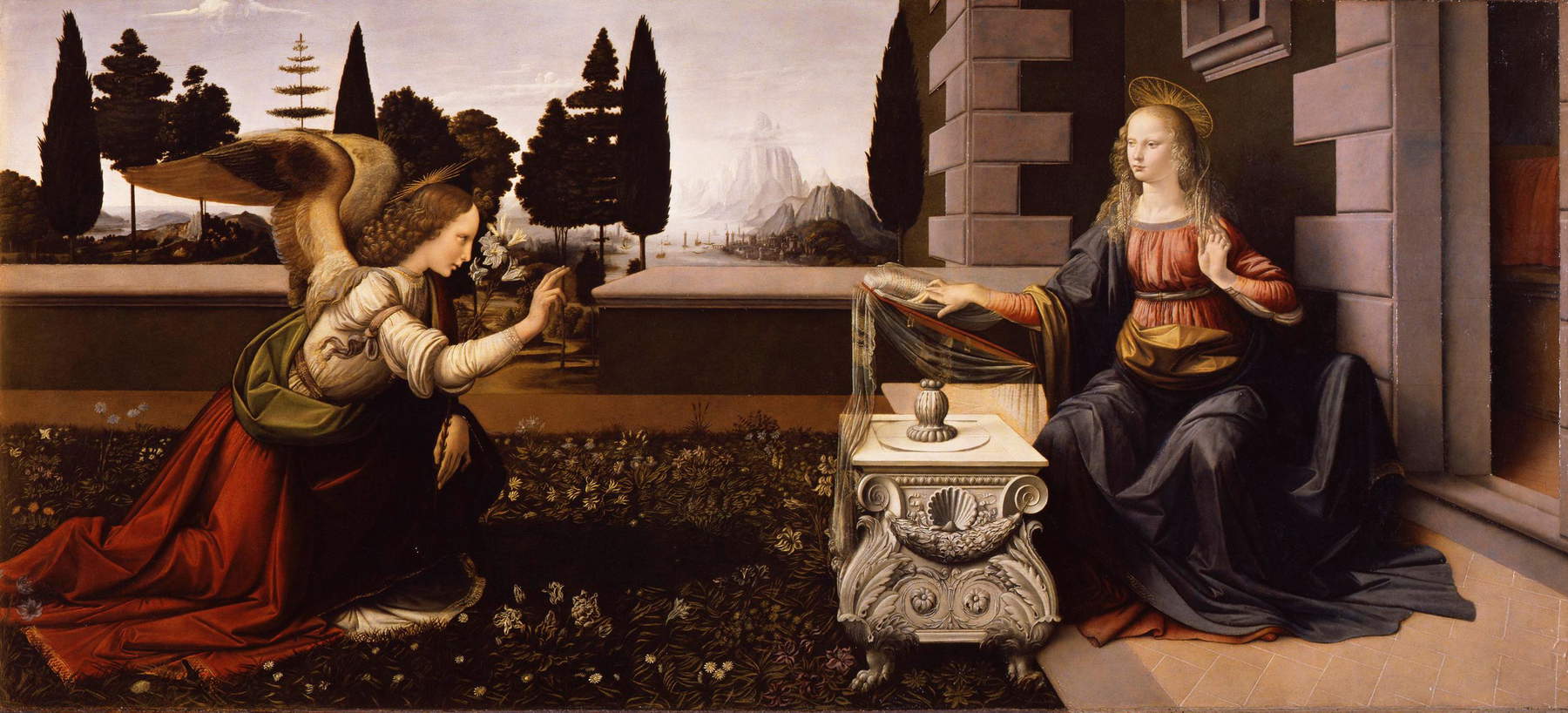



This is what scholar Laura Teza thought in 1997, the first to formulate the hypothesis that some members of the family could be recognized in the Magi (an idea that, as will be seen below, was instead rejected by Marco Pierini). The eldest, the magician Gaspare, would thus conceal the features of Malatesta I Baglioni, a valiant Perugian captain of fortune who was at the origin of the family fortunes and who was considered a sort of pater patriae by his fellow citizens precisely because thanks to his work the family was able to dominate Perugia for about a century. He was never to become lord of Perugia and had to content himself with the title of lord of Bettona, Cannara and Spello: instead, the one who succeeded in the feat was his son Braccio I Baglioni, the first lord of Perugia (albeit de facto and therefore never officially invested with the title), who according to Teza would be represented with the appearance of the mature Mago, Baldassarre. Finally, in the figure of Melchior, i.e., the youngest of the Magi, would be to recognize the portrait of Grifone Baglioni, Braccio’s son and at the time of the execution of the painting destined to become his successor (he would not succeed because he fell in battle in 1477, two years before his father’s death).
The hypothesis, as mentioned, has been discarded by Marco Pierini: “not only,” the art historian writes, “are Perugino’s Magi devoid of all typical portrait connotations, but they fully reflect those standard physiognomies replicated by the artist whenever the situation allowed it.” However, the involvement of the Baglioni family, who at the time held de facto power over the city that was officially ruled by the pope, in the commission of the painting, which was executed for the church of Santa Maria dei Servi in Perugia, has been deemed likely. The house of worship, later demolished in 1540 to allow for the construction of the Rocca Paolina, was located on Colle Landone, a small rise that is no longer visible today as it is completely urbanized (it is the area of the historic center near the remains of the Rocca Paolina, where a number of buildings such as the Banca d’Italia, Hotel Brufani, and the Palazzo della Provincia stand), not far from the Baglioni houses. Some members of the family had also been buried inside the church.
We have no idea how the Baglioni knew Perugino. However, wrote Marco Pierini, “Braccio had such a familiarity with Florence that this does not seem at all inexplicable. They could also have acted as mediators the same servants, with whom the painter-who received numerous commissions from them, including one for the mother house of the Santissima Annunziata in Florence-had long had a solid bond precisely from his youthful years.” Moreover, an intermediary role may have been played by the painter’s uncle, Pietro Lazzari, who was procurator general of the Order of Servites between 1463 and 1467.
The work remained in the church until the date of its demolition, when it was then moved to the new building that was to replace the old church of the Servites, namely the church of Santa Maria Nuova in Porta Sole. The painting managed to escape the Napoleonic spoliations but not the lists of the new curator of the Capitoline Museum in Rome, Agostino Tofanelli, who in 1812 selected the altarpiece for the museum and two years later had it moved to the Capitol, despite the protests of the Perugians. It was then returned to Perugia in 1820, being allowed to return to its church. It was then transferred in 1863 to the Pinacoteca Civica di Perugia (which had opened that very year), or the museum that would later become the present National Gallery of Umbria. And it was immediately at the center of an attributive debate, since, for some reason, certainty about its authorship had been lost: Giovanni Battista Cavalcaselle in 1866 attributed it to Fiorenzo di Lorenzo, and like him did Bernard Berenson in 1897 (who later retraced his steps, however), until in 1903 Jean Carlyle Graham returned to formulating Perugino’s name, and in 1911 Adolfo Venturi put a stop to the question by reaffirming the authorship of the young master from Città della Pieve. In any case, since that 1863 it has been in the rooms of Palazzo dei Priori in Perugia that one can admire theAdoration of the Magi, a fascinating witness to a changing world, both culturally and politically, the first masterpiece of an artist destined to become one of the greats of his time.
The article is written as part of “Pills of Perugino,” a project that is part of the initiatives for the popularization and dissemination of knowledge of the figure and work of Perugino selected by the Promoting Committee of the celebrations for the fifth centenary of the death of the painter Pietro Vannucci known as “il Perugino,” established in 2022 by the Ministry of Culture. The project, edited by the editorial staff of Finestre Sull’Arte, is co-financed with funds made available to the Committee by the Ministry.
Warning: the translation into English of the original Italian article was created using automatic tools. We undertake to review all articles, but we do not guarantee the total absence of inaccuracies in the translation due to the program. You can find the original by clicking on the ITA button. If you find any mistake,please contact us.